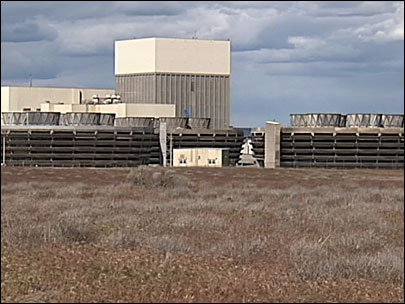forum
library
tutorial
contact

Inside Hanford: A Tour of the
NW's Only Nuclear Power Plant
by Dan TilkinKATU, May 5, 2011
|
the film forum library tutorial contact |

|
Inside Hanford: A Tour of the
by Dan Tilkin |
 HANFORD SITE, Wash. -- The Columbia Generating Station near the Columbia River provides nine percent of the electricity used in Washington, and underneath a building of unremarkable architecture is an army of 1,800 workers.
HANFORD SITE, Wash. -- The Columbia Generating Station near the Columbia River provides nine percent of the electricity used in Washington, and underneath a building of unremarkable architecture is an army of 1,800 workers.
They are replacing the $100 million system that cools steam after it's been used to create electricity. In another part of the building they are engaged in the delicate work of replacing a third of the uranium fuel inside the reactor room.
The old radioactive rods are moved into a pond where they will cool down for at least five years.
Everyone wears radiation monitors. If they start beeping, there's trouble. There are also heavily armed guard towers, and seemingly endless checkpoints.
In the control room technicians have watched warning systems since the plant came to life in the mid-1980s. The equipment is a throwback to another era.
"Keep in mind, everything you see in here was designed in the late 60s, early 70s, many of the components in here are from that same era," said Carl Golightly with Energy Northwest.
There are assurances from officials that the old technology is tried and true, and the plant can withstand a 6.4 earthquake.
In recent years more generators have been added to keep the cooling system running if there's a power failure and to prevent a crisis like the one that is happening in Japan after the earthquake.
Chief nuclear officer for Energy Northwest, Brad Sawatzke, said it's too soon to tell if the crisis in Japan will be a setback to building new plants in the United States.
"I don't have enough information. We don't have enough information yet to all the details, specifics as to what happened that I can give you an honest answer of how big an effect it will be," he said.
The Energy Northwest plant is separate from the U.S. Department of Energy's nuclear facilities that have been at the sprawling Hanford Reservation since World War II.
Efforts to dismantle the federal government's atomic past are going forward. There are mothballed reactors never finished and there are nine former functioning reactors including the one used to develop the atomic bomb dropped on Nagasaki, Japan.
There are 53 million gallons of radioactive waste buried underground at the site. That is enough to cover 123 football fields a foot deep. But that contamination isn't from the Columbia Generating Station. Its spent fuel is stored in casks until the United States establishes a permanent dumpsite.
The plant is supposed to be retired in 2024 but the operators believe there is still a lot of life in the facility. They've applied to keep running it until 2044.
The plant is not part of the federal government's Cold War activities at Hanford that produced plutonium for most of the 60,000 weapons in the U.S. nuclear arsenal.
The overall Hanford site is the largest nuclear waste dump in the Western Hemisphere, and it has the only functioning nuclear power plant in the Northwest.
Related Sites:
Chernobyl: A Million Casualties EnviroVideo Karl Grossman interviews Janette Sherman, M.D., toxicologist.
learn more on topics covered in the film
see the video
read the script
learn the songs
discussion forum
